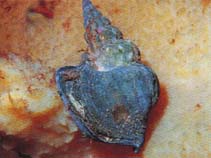Aporrhais occidentalis Beck, 1836
American pelicanfootWarning: DOMDocument::load(): SSL operation failed with code 1. OpenSSL Error messages: error:140770FC:SSL routines:SSL23_GET_SERVER_HELLO:unknown protocol in C:\Apache24\htdocs\includes\SpeciesSummary.lib.php on line 1236
Warning: DOMDocument::load(): Failed to enable crypto in C:\Apache24\htdocs\includes\SpeciesSummary.lib.php on line 1236
Warning: DOMDocument::load(https://sealifebase.nrm.se/webservice/AquaMaps/getAMap.php?genus=Aporrhais&species=occidentalis): failed to open stream: operation failed in C:\Apache24\htdocs\includes\SpeciesSummary.lib.php on line 1236
Warning: DOMDocument::load(): I/O warning : failed to load external entity "https://sealifebase.nrm.se/webservice/AquaMaps/getAMap.php?genus=Aporrhais&species=occidentalis" in C:\Apache24\htdocs\includes\SpeciesSummary.lib.php on line 1236
Classification / Names Common names | Synonyms | CoL | ITIS | WoRMS
| Littorinimorpha | Aporrhaidae
Environment: milieu / climate zone / depth range / distribution range Ekologi
; djupintervall 4 - 1829 m (Ref. 83435). Boreal; 67°N - 36°N, 79°E - 56°E (Ref. 83435)
Utbredning Länder | FAO områden | Ekosystem | Förekomster | Utplanteringar
Arctic and North America.
Length at first maturity / Size / Vikt / Age
Maturity: Lm ? range ? - ? cm Max length : 7.0 cm DL hane/ej könsbestämd; (Ref. 83435); common length : 5.1 cm SHL hane/ej könsbestämd; (Ref. 360)
Short description Morfologi
Shell: high conical spire, rather thick and solid, with swollen whorls and very impressed sutures; outer lip is broadened and forms a large unfingered expansion; both outer and columellar lips are strongly thickened; sculpture consists of a score of strong well-spaced axial ribs, usually curving, also a spiral ornament of thin, deeply incised grooves, especially marked on the body whorl; whitish cream or grayish in color; the operculum is very small, horny and ellipsoidal, with smooth edges. Body: similar to the strombids, especially in the structure of the long and narrow foot with a smaller anterior lobe and a large posterior one that bears the operculum and enables the mollusk to leap; eyes are not pedunculated, but are at the base of the tentacles; mantle cavity contains only one gill, the osphradium and in males, the copulatory organ; radula is taenioglossan.
Life cycle and mating behavior Könsmognad | Reproduktion | Lek | Ägg | Fecundity | Larver
Members of the order Neotaenioglossa are mostly gonochoric and broadcast spawners. Life cycle: Embryos develop into planktonic trocophore larvae and later into juvenile veligers before becoming fully grown adults.
Main reference
referenser | Koordinator | Medarbetare
Sabelli, B. and H.S. Feinberg (eds.). 1879. (Ref. 360)
IUCN Red List Status (Ref. 130435)
CITES status (Ref. 108899)
Not Evaluated
CMS (Ref. 116361)
Not Evaluated
Threat to humans
Human uses
| FishSource |
Verktyg
Ytterligare information
Internet-källor
BHL | BOLD Systems | CISTI | DiscoverLife | FAO(Publication : search) | Fishipedia | GenBank (genome, nucleotide) | GloBI | Gomexsi | Google Books | Google Scholar | Google | PubMed | Tree of Life | Wikipedia (Go, sök) | Zoological Record
Estimates based on models
Price category
(Ref. 80766):
Unknown.



